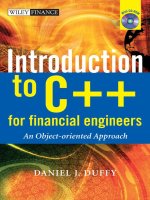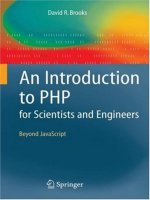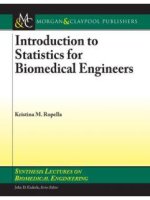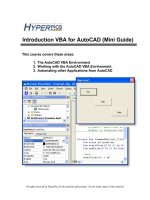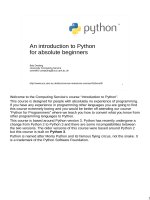gentle introduction to mathematics for computer
Bạn đang xem bản rút gọn của tài liệu. Xem và tải ngay bản đầy đủ của tài liệu tại đây (3.54 MB, 153 trang )
Gareth J. Janacek; Mark Lemmon Close
Mathematics for Computer
Scientists
Download free books at
Download free eBooks at bookboon.com
2
Gareth J. Janacek & Mark Lemmon Close
Mathematics for Computer Scientists
Download free eBooks at bookboon.com
3
Mathematics for Computer Scientists
© 2011 Gareth J. Janacek, Mark Lemmon Close & Ventus Publishing ApS
ISBN 978-87-7681-426-7
Download free eBooks at bookboon.com
Click on the ad to read more
Mathematics for Computer Scientists
4
Contents
Contents
Introduction 5
1 Numbers 6
2 e statement calculus and logic 20
3 Mathematical Induction 35
4 Sets 39
5 Counting 49
6 Functions 56
7 Sequences 73
8 Calculus 83
9 Algebra: Matrices, Vectors etc. 98
10 Probability 119
11 Looking at Data 146
www.sylvania.com
We do not reinvent
the wheel we reinvent
light.
Fascinating lighting offers an infinite spectrum of
possibilities: Innovative technologies and new
markets provide both opportunities and challenges.
An environment in which your expertise is in high
demand. Enjoy the supportive working atmosphere
within our global group and benefit from international
career paths. Implement sustainable ideas in close
cooperation with other specialists and contribute to
influencing our future. Come and join us in reinventing
light every day.
Light is OSRAM
Download free eBooks at bookboon.com
Mathematics for Computer Scientists
5
Introduction
Introduction
The aim of this book is to present some the basic mathematics that is needed by
computer scientists. The reader is not expected to be a mathematician and we
hope will find what follows useful.
Just a word of warning. Unless you are one of the irritating minority math-
ematics is hard. You cannot just read a mathematics book like a novel. The
combination of the compression made by the symbols used and the precision of
the arg ument makes this impossible. It takes time and effort t o decipher the
mathematics and understand the meaning.
It is a little like programming, it takes time to understand a lot of code and
you never understand how to write code by just reading a manual - you have to
do it! Mathematics is exactly the same, you need to do it.
Download free eBooks at bookboon.com
Mathematics for Computer Scientists
6
Numbers
Chapter 1
Numbers
Defendit numerus: There is safety in numbers
We begin by talking about numbers. This may seen rather elementary but is does
set the scene and introduce a lot of notation. In addition much of what follows is
important in computing.
1.0.1 Integers
We begin by assuming you a re familiar with the integers
1,2,3,4,. . .,101,102, . . . , n, . . . , 2
32582657
− 1, . . .,
sometime called the whole numbers. These are just the numbers we use for count-
ing. To these integers we add the zero, 0, defined as
0 + any integer n = 0 + n = n + 0 = n
Once we have the integers and zero mathematicians create negative integers by
defining (−n) as:
the number which when added to n gives zero, so n + (−n) = (−n) + n = 0.
Eventually we get fed up with writing n+(−n) = 0 and write this as n−n = 0.
We have now got the positive and negative integers {. . . , −3, −2, −1, 0, 1, 2, 3, 4, . . .}
You are probably used t o arithmetic with integers which follows simple rules.
To be on the safe side we itemize them, so for integers a and b
1. a + b = b + a
2. a × b = b ×a o r ab = ba
3. −a
×
b = −ab
Download free eBooks at bookboon.com
Mathematics for Computer Scientists
7
Numbers
4. (−a) × (−b) = ab
5. To save space we write a
k
as a shorthand for a multiplied by itself k times.
So 3
4
= 3 ×3 ×3 ×3 and 2
10
= 1024. Note a
n
× a
m
= a
n+m
6. Do note that n
0
=1.
Factors and Primes
Many integers are products of smaller integers, for example 2 × 3 × 7 = 42. Here
2, 3 and 7 are called the factors of 42 a nd the splitting of 4 2 into the individual
components is known as factorization. This can be a difficult exercise for large
integers, indeed it is so difficult that it is the basis of some methods in cryptography.
Of course not all integers have factors and those that do not, such as
3, 5, 7, 11, 13, . . . , 2
216091
− 1, . . .
are known as primes. Primes have long fascinated mathematicians and others see
/>and there is a considerable industry looking for primes and fast ways of factorizing
integers.
To get much further we need to consider division, which for integers can be
tricky since we may have a result which is not a n integer. Division may give rise
to a remainder, for example
9 = 2 × 4 + 1.
and so if we try to divide 9 by 4 we have a remainder of 1 .
In general for any integers a and b
b = k × a + r
where r is the remainder. If r is zero then we say a divides b written a | b. A
single vertical bar is used to denote divisibility. For example 2 | 128, 7 | 49 but 3
does not divide 4, symbolically 3 ∤ 4.
Aside
To find the factors of an integer we can just a ttempt division by primes i.e.
2, 3, 5, 7, 11, 19, . . . . If it is divisible by k then k is a factor and we try again.
When we cannot divide by k we take the next prime and continue until we are left
with a prime. So for example:
1. 2394/2=1197 can’t divide by 2 again so try 3
Download free eBooks at bookboon.com
Mathematics for Computer Scientists
8
Numbers
2. 1197/3=399
3. 399/3 = 133 can’t divide by 3 again so try 7 ( not divisible by 5)
4. 133/7 = 19 which is prime so 2394 =2 × 3 × 3 × 7 × 19
Modular arithmetic
The mod operator you meet in computer languages simply gives the remainder
after division. For example,
1. 25 mod 4 = 1 because 25 ÷ 4 = 6 remainder 1.
2. 19 mod 5 = 4 since 19 = 3 × 5 + 4 .
3. 24 mod 5 = 4.
4. 99 mod 11 = 0.
There are some complications when negative numbers are used, but we will ignore
them. We also point out that you will often see these results written in a slightly
different way i.e. 24 = 4 mod 5 or 21 = 0 mod 7. which just means 24 mod 5 =
4 and 27 mod 7 = 0
Modular arithmetic is sometimes called clock arithmetic. Suppose we take a
24 hour clock so 9 in the morning is 09.00 and 9 in the evening is 21.00. If I start
a journey at 07.00 and it takes 25 hours then I will arrive at 08.00. We can think
of this as 7+25 = 32 and 32 mod 24 = 8. All we are doing is starting at 7 and
going around the (25 hour) clock face until we get to 8. I have always thought this
is a complex example so take a simpler version.
Four people sit around a table and we la bel their positions 1 to 4. We have a
pointer point to position 1 which we spin. Suppose it spins 11 a nd three quarters
or 47 quarters. The it is pointing at 47 mod 4 or 3.
1
2
3
4
✻
❑
or 21 =
Download free eBooks at bookboon.com
Click on the ad to read more
Mathematics for Computer Scientists
9
Numbers
The Euclidean algorithm
Algorithms which are schemes for computing and we cannot resist putting one
in at this point. The Euclidean algorithm for finding the gcd is one of the oldest
algorithms known, it appeared in Euclid’s Elements around 300 BC. It gives a way
of finding the greatest common divisor (gcd) of two numbers. That is the largest
number which will divide them both.
Our aim is to find a a way of finding the greatest common divisor, gcd(a, b) of
two integers a and b.
Suppose a is an integer smaller than b.
1. Then to find the greatest common factor between a and b, divide b by a. If
the remainder is zero, then b is a multiple of a and we are done.
2. If not, divide the divisor a by the remainder.
Continue this process, dividing the last divisor by the last remainder, until the
remainder is zero. The last non-zero remainder is then the greatest common factor
of the integers a and b.
360°
thinking
.
© Deloitte & Touche LLP and affiliated entities.
Discover the truth at www.deloitte.ca/careers
Download free eBooks at bookboon.com
Mathematics for Computer Scientists
10
Numbers
The algorithm is illustrated by the following example. Consider 72 and 246.
We have the following 4 steps:
1. 246 = 3 ×72 + 30 or 246 mod 72 = 30
2. 72 = 2 ×30 + 12 or 72 mod 30 = 12
3. 30 = 2 ×12 + 6 or 30 mod 12 = 6
4. 12 = 2 ×6 + 0
so the gcd is 6.
There are several websites that offer Java applications using this algorithm, we
give a Python function
def gcd(a,b):
""" the euclidean algorithm """
if b == 0:
return a
else:
return gcd(b, (a%b))
Those of you who would like to see a direct application of some these ideas to
computing should look at the section on random numb ers
1.0.2 Rationals and Reals
Of course life would be hard if we only had integers and it is a short step to the
rationals or fractions. By a rational number we mean a numb er that can be written
as P/Q where P and Q are integers. Examples are
1
2
3
4
7
11
7
6
These numbers arise in an obvious way, you can imagine a ruler divided into ’iths’
and then we can measure a length in ’iths’. Mathematicians, of course, have more
complicated definitions based on modular arithmetic . They would argue that for
every integer n, excluding zero, there is an inverse, written 1/n which has the
property that
n ×
1
n
=
1
n
× n = 1
Of course multiplying 1 /n by m gives a fraction m/n. These are often called
rational numbers.
We can manage with the simple idea of fractions.
Download free eBooks at bookboon.com
Mathematics for Computer Scientists
11
Numbers
One problem we encounter is that there are numbers which are neither integers
or rationals but something else. The Greeks were surprised and confused when it
was demonstrated that
√
2 could not be written exactly as a fraction. Technically
there are no integer values P and Q such that P/Q =
√
2.
From our point of view we will not need to delve much further into the details,
especially as we can get good enough approximation using fractions. For example
22/7 is a reasonable approximation for π while 355/113 is better. You will find
people refer to the real numbers, sometimes written R, by which they mea n all the
numbers we have discussed to date.
Notation
As you will have realized by now there is a good deal of notation and we list some
of the symbols and functions you may meet.
• If x is less than y then we write x < y. If there is a possibility that they
might be equal then x ≤ y. Of course we can write these the other way
around. So y > x or y ≥ x. Obviously we can also say y is g reat er than x
or greater than o r equal to x
• The floor function of a real number x, denoted by ⌊x⌋ or floor(x), is a
function that returns the larg est integer less than or equal to x. So ⌊2.7⌋ = 2
and ⌊−3.6⌋ = −4. The function floor in Java and Python performs this
operation. There is an obvious(?) connection to mod since b mod a can
be written b−floor(b÷a)×a. So 25 mod 4 = 25−⌊25/4⌋×4 = 25−6×4 =
1
Download free eBooks at bookboon.com
Mathematics for Computer Scientists
12
Numbers
• A less used function is the ceiling function, written ⌈x⌉ or ceil(x) or ceiling(x),
is the function that returns the smallest integer not less than x. Hence
⌈2.7⌉ = 3.
• The modulus of x written | x | is just x when x ≥ 0 and −x when x < 0. So
| 2 |= 2 and | −6 |= 6. The famous result about the modulus is that for any
x and y
| x + y |≤| x | + | y |
• We met a
b
when we discussed integers and in the same way we can have x
y
when x a nd y are not integers. We discuss this in detail when we meet the
exponential function. Note however
– a
0
=1 for all a = 1
– 0
b
= 0 for all values of b including zero.
1.0.3 Number Systems
We are so used to working in a decimal system we forget that it is a recent invention
and was a revolutionary idea. It is time we looked carefully at how we represent
numbers. We normally use the decimal system so 3459 is shorthand for 3 + 4 ×
100+ 5+ 9. The position of the digit is vital as it enables us to distinguish between
30 and 3. The decimal system is a positional numeral system; it has positions for
units, tens, hundreds and so on. The position of each digit implies the multiplier
(a power of ten) to be used with that digit and each position has a value ten times
that of the position to its right.
Notice we may save space by writing 1000 as 10
3
the 3 denoting the number of
zeros. So 100000 = 10
5
. If the superscript is negative then we mean a fraction e.g
10
3
= 1/1000. Perhaps the cleverest part of the positional system was the addition
of the decimal point allowing us to include decimal fractions. Thus 123.456 is
equivalent to
1 ×100 + 2 × 10 + 3 + numbers after the point +4 × 1/10 + 5× 1/100 + 6 × 1/1000
Multiplier . . . 10
2
10
1
10
0
. 10
−1
10
−2
10
−3
. . .
digits . . . 1 2 3 . 4 5 6 . . .
↑
decimal point
However there is no real reason why we should use powers of 10, or base 10.
The Babylonians use base 60 and base 12 was very common during the middle
ages in Europe. Today the common number systems are
3459 is shorthand for 3 x 1000 + 4 x
100 + 5 x 10 + 9.
Download free eBooks at bookboon.com
Mathematics for Computer Scientists
13
Numbers
• Decimal number system: symbols 0-9; base 10
• Binary number system:symbols symbols 0,1; base 2
• Hexadecimal number system:symbols 0-9,A-F; base 16
here A ≡ 10 , B ≡ 11 , C ≡ 12 , D ≡13 E ≡ 14 , F≡ 15.
• Octal number system: symbols 0-7; base 8
Binary
In the binary scale we express numbers in powers of 2 rather than the 10s of the
decimal scale. For some numbers this is easy so, if recall 2
0
= 1,
Decimal in powers of 2 power of 2 Binary number
number 3 2 1 0
8 = 2
3
1 0 0 0 1000
7 = 2
2
+ 2
1
+ 2
0
0 1 1 1 111
6 = 2
2
+ 2
1
0 1 1 0 110
5 = 2
2
+ 2
0
0 1 0 1 101
4 = 2
2
0 1 0 0 100
3 = 2
1
+ 2
0
0 0 1 1 11
2 = 2
1
0 0 1 0 10
1 = 2
0
0 0 0 1 1
As in decimal we write this with the position of the digit representing the power,
the first place after the decimal being the 2
0
position the next the 2
1
and so on.
To convert a decimal number to binary we can use our mod operator.
As an exa mple consider 88 in decimal or 88
10
. We would like to write it as a
binary. We take the number and successively divide mod 2. See below
Step number n x
n
⌊x
n
/2⌋ x
n
mod 2
0 88 44 0
1 44 22 0
2 22 11 0
3 11 5 1
4 5 2 1
5 2 1 0
6 1 0 1
Writing the last column in reverse, that is from the bottom up, we have 1011000
which is the binary for of 88, i.e.88
10
= 1011000
2
.


